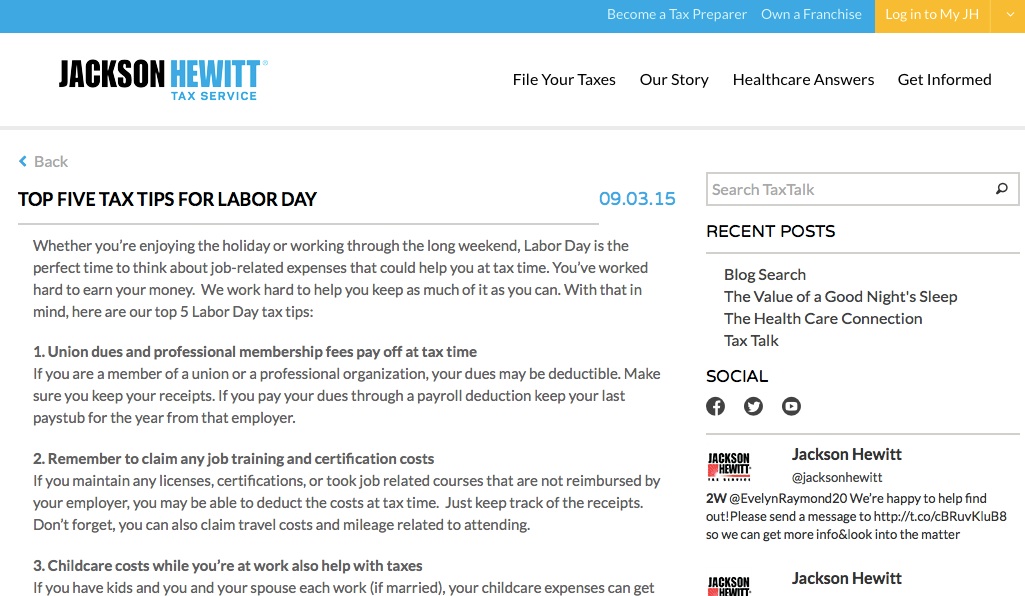Two things are certain, death and taxes.
For the most part, though, you have a choice in how you want to experience one of these. Taxes are everything from a political talking point to a right of passage to conversation starter.
Whatever they are to you, they are a great business. Why? Because tax software companies have so many things to write about! And you know what happens when you approach your content strategically? People read what you have to say, and then, when the time comes, they will look to you, Mr. and Miss Tax Software Companies, to help them out.
Yes, it’s true. That one thing that many people struggle with is a source of income for you. You know this, of course. That’s why you run a tax software company. You’re there to help people and businesses with the struggle, and in return, they pay you.
Here’s the catch, though. There are a lot of tax software companies out there vying for business. In a competitive environment, you have to stand out in order to be successful. And to stand out, you have to do three things: offer a great product, offer superior customer service, and let people know what you offer.
Simple enough, right? Only, your competition is also offering a great product and great customer support. You, however, have an advantage – or you could, at least – through your blog. A strategic content marketing plan for your blog and social media outlets is how people are going to find you.

Steal these post ideas
But first…
You should know a few things. Google search results depend on keywords. Without going into a lot of Search Engine Optimization (SEO) jargon, I’ll just tell you that keywords are what people are looking for, and what Google uses to help them find you. The keywords in the following title ideas are in red. Don’t change them! You can change the rest of the title entirely if you like, but the keywords must remain as they are, otherwise all that research I’ve done for you goes down the tubes. These are phrases that people are looking for, and that have limited competition.
The ten companies who have their blogs used here as examples are already a step ahead of the competition. Why? Because they have blogs! It is much harder to find tax company blogs than I would have guessed. This is good news for you, though. Once you get your blog firing on all eight cylinders you won’t have to worry about the competition.
[Tweet “Once you get your blog firing on all eight cylinders you won’t have to worry about the competition.”]Another word about these ten examples: They didn’t ask to be here, and while I do point out areas where they could improve, it comes from a place of good intentions. Heck, it’s not easy being the example, and none among us is flawless, so when you read this, bear in mind that this is a learning opportunity, not a slamfest (assuming that’s even a thing).
Alright. Ready? Here you go.
Blog ideas for tax software companies
1. Know your audience
Title: The 1099 tax form: What You Need to Know
Suggested Call to Action: “You have enough on your plate as an independent contractor. Don’t let the 1099 tax form bog you down. Try our tax software free for 30 days and see how easy we can make your accounting life.”
The Zen99 blog does a nice job of identifying some of the deductions you can take with the 1099. Independent contractors and self-employed business people want to know how they can make the most of their expenses. After all, working for yourself can be expensive.
By using a good keyword, Zen99 is attracting an audience that is actively seeking tax help. Those people, in turn, will look to Zen99 when they decide that it’s time to enlist help in maintaining records and filing taxes.
That’s precisely why your tax software company blog can help bring business to your door. You’re blog establishes you as a trusted source.
2. Write for your audience
Title: Tax Software for Professionals Who Don’t Have Time to Fool Around
Suggested Call to Action: “When you have customers waiting to find out if they owe taxes or can expect a refund, you don’t have time to fool around. Your reputation is on the line. We’re here to help. Try our tax software for professionals free for 30 days to find out how you can amaze your clients.”
Canopy is software designed for the tax professional. Their blog is evidence of that, with titles aimed at networking and social media for accountants. At the moment, it looks like their blog is fairly new, so it’s tough to say what kind of return they are seeing from it.
This much I know: When you know who your are trying to reach with your tax software, your blog can be tightly focused. Choose and use your keywords wisely, and before you know it, your customers will be knocking on your virtual door.
3. Take tips from the big guys
Title: Your Self-Employed Tax Return Doesn’t Need to be a Nightmare
Suggested Call to Action: “Working for yourself comes with its own set of advantages. Doing your own taxes isn’t usually on that list, but your self-employed tax return doesn’t need to be the bane of your existence. Join us for a free trial of our tax software and you might just look forward to tax time.”
I’ve got to hand it to Turbotax; they do an excellent job with their blog. They post regularly. They offer good content. They include a call to action in each post. All of these tasks work together to create a powerful online presence. I’d be willing to bet that Turbotax has a department just for marketing, but that doesn’t mean smaller tax software companies can’t replicate this winning strategy.
Once you set up an editorial calendar, and dedicate some staff time each week to writing and upkeep, your blog can become one of your most cost-effective marketing tools. (Or you could hire us to do it for you).
4. Make your blog a valuable resource
Title: Save Big with these Tax Deductions for Students
Suggested Call to Action: “College students are learning a lot, including how to do taxes for the first time. Don’t forget these tax deductions for students when it comes time to file. Our tax software is here to help you remember. Join us for a free trial.”
TaxAct is another big player in the online tax software world. Their blog covers almost anything you could think of, from the Nanny tax to budgeting tips for childrens’ sports. Posts are in-depth and they all have a call to action.
Like Turbotax, TaxAct probably has a marketing department that handles the blog for them. You don’t need a marketing department to take tips from them, though. A few well-written articles will trump several poorly written ones every time. So even though we advise posting at least twice per week to gain traction in Google search, if you find you can only write one, make it the best you can. The quality of your writing will reflect well on your product.
5. Be personable
Title: What Can I Write Off on My Taxes?
Call to Action: “There is one question that comes up most during tax season, “What can I write off on my taxes?” Our tax software automatically scans your return for possible deductions, leaving you free to worry about where you should go on vacation.”
I’ll admit I’m a sucker for a good pun. The ESmart Tax blog is called “The Daily Deduction” and I love the play on both a daily newspaper and tax lingo. Likewise, ESmart has a nice soft-sell call to action at the end of most of their posts. Between the call to action and the sense of humor, I would guess they draw in readers who need a bit of relief from the stress of working on their taxes.
You can use an approach like this for your tax software blog, too. Something as serious as taxes could use a lighthearted moment here and there, to help your readers relax and feel comfortable with your company. One point I will mention, though, is that there are no dates on the posts, and based on titles, it looks like ESmart has only posted four times since April 15. If you are just starting your blog, or in a place where you need visibility, posting two or three times each week is one of the steps you’ll need to take.
6. Make it Easy to Stay
Title: Are you confused by the IRS Tax Guide?
Suggested Call to Action: “We get it. Taxes can be confusing. The IRS tax guide is helpful, but it can be overwhelming. Join us for a free trial. We’ll walk you through your taxes and leave you feeling refreshed.”
I like that the 1040.com blog is a bit tongue in cheek. I like that they post regularly. Their blog voice is very approachable, which, really, is what you want. Even when you are marketing a professional product, you are still marketing to real people. Remember that when you start writing your blog.
1040.com misses out, though. Their blog posts either do not have a call to action, or if they do, they don’t make it easy for me to follow through with a clickable link. Adding both of these in could keep me around a bit longer, increasing the chance that I’ll register with them. You don’t want to create any barrier to your visitor being able to connect with you. Make it easy for them to sink into your site and give them a chance to become your next loyal customer.
7. Use video or infographics
Title: File Business Taxes Online and Skip the Line
Suggested Call to Action: “The line at the post office on April 15 can be long, and there’s always someone ahead of you who has to see every single stamp before they are done. You don’t have to wait behind them anymore. File business taxes online with our online tax software. Try it free for 14 days and see how much time you can save.”
We’ve written about H&R Block before. There’s no denying they are the biggest name in tax preparation. As blogs go, they’ve pretty much got the golden ticket. Infographics, videos, and traditional blog posts fill the page with information on everything from refunds to keeping receipts. They also have the luxury of a marketing budget that startups and small tax software companies just can’t compete with.
Here’s the good news: you don’t have to compete with H&R Block. A small investment in your company blog can bring you visitors for years to come if you handle it strategically. And because you’re not a major corporation like H&R Block, you can share your personality in a way that they can’t.
That doesn’t mean you can’t pick up ideas from them, like using a call to action and posting content that solves your readers’ problems. Your readers will love you for it, which means they will want to do business with you when the time comes.
8. Include a call to action
Title: Don’t Let the Extended Tax Deadline Pass You By
Suggested Call to Action: “The extended tax deadline is approaching quickly. Don’t get caught with your accounting in a bind. Try our tax help software free for 14 days. We promise you’ll love it.”
Like Canopy, the TaxSlayer Pro blog offers some great suggestions for tax professionals. The blog posts are informative and helpful. But TaxSlayer Pro could take more advantage of their blog by publishing more frequently, and by adding a call to action in each post. Someone coming to a post to find out about a tax deadline could get what they want here, but then they could easily click away.
A call to action gives your reader the opportunity to easily click to your sales page. You’ve already built some trust through your helpful blog article. Use that early stage trust to continue building a relationship with your reader.
9. Offer relevant information
Title: Relax at Home and File Taxes Online for Free
Suggested Call to Action: “Wouldn’t you rather be at home curled up on your couch than out doing taxes? Good news! You can file taxes online for free with us! Join the wave of the future, and let your taxes be an excuse to order out.”
I’ll be honest. I’m not quite sure if the DIY Tax blog has anything to do with taxes. There are a few things for you to learn here, though. Let’s start with the call to action. DIY Tax does end some (not all) of their posts with a call to action inviting the reader to follow them on Facebook. And they do give money saving suggestions.
I won’t be too hard on them because it looks like their blog is new. Right now it seems like there are five or six posts. I also won’t be too hard on them because, unlike so many online tax services and tax software companies, they do at least have a blog.
Unfortunately, the blog also leaves me a bit lost. I’m all for saving money, but if I am reading a tax blog I want useful information about my taxes. Let’s be real, no one is going to read a tax blog just for kicks, so you have to provide value. This seems to me like a missed opportunity to share ways to save money (which they do), but then also use those strategies to save on your taxes.
Props to DIY Tax for starting a blog, though. I know it isn’t an easy thing to get off the ground, and it can seem like a time-vacuum if you aren’t seeing a return. (Incidentally, we can help you with that).
10. Make it easy for your reader to click
Title: Free Federal Tax Filing Lets You Keep Your Hard Earned Money
Suggested Call to Action: “Don’t give your money away! We offer free federal tax filing for anyone filing a 1040EZ form. Not sure which one you should file? Sign up for our form finder, and you can started on your tax return right away.”
Jackson Hewitt is another of the big names in taxes. I usually prefer to feature smaller companies when I write posts like these, but there just aren’t that many tax services that have blogs. Unfortunate, too, as a good company blog can offer an outstanding return on your marketing dollars.
That’s going to change, though. Right? Great! So let’s take a look at Jackson Hewitt’s blog posts. There are some good things here that you can take note of for starting your blog, and a few mistakes to avoid.
Jackson Hewitt does a fabulous job targeting a specific audience. They have tax tip posts directed at military personnel, systems administrators, parents, postal workers – you get the idea. This is useful, actionable information. It provides value to me, as a reader, and it sets up Jackson Hewitt as an authority on tax questions. All good stuff.
There also happen to be a few points where they could improve their blog. First, they don’t publish their blog posts regularly; they seem to happen in spurts. Posting on a schedule looks more professional and also lets you promote yourself more regularly.
Another missed opportunity is in their call to action – or rather, it’s not in their call to action. They do end each post with a CTA, which is great, and you should always, always do that. But there is no clickable link in them! Ok, I’ve read the post about tax tips for parents. I really could use some help with figuring out childcare deductions. There is a CTA that informs me all I have to do is contact them and I can ask! Awesome! But…..where the heck do I do that?
Please, folks, make sure your call to action has a clickable link that aligns with your goal. Do you want people to sign up for a mailing list? Make sure that link goes to a mailing list sign up form. Are you asking people to register with you for free tax advice? Wonderful. That link needs to go to a registration page.
For a company as large and well-known as JH, this might not be a deal breaker. They probably aren’t running with a tight marketing budget like you are. And I’m sure JH hates to miss out on opportunities to make a sale, but losing a few here and there won’t put them out of business. Still, though, blogs can bring you business for years to come, so why not make the most of it?
So there you are, friends: ten blog post ideas for your tax software company. These examples should give you a good idea of where you can go with a blog, as well as a few things to stay away from. Whatever you do write, just make sure you are offering valuable information to your reader. Your blog is a marketing tool, but it isn’t about you; it’s about what your reader gets out of it.
Also, be sure to include your call to action so your readers can contact you and learn more about the benefits they can get from working with you. Like this:
You know how useful a company blog can be, you just don’t have the time to dedicate to it. This means you are missing out on an audience – your audience. We can fix that for you. Work with us and you get a dedicated team with a proven method for bringing traffic and sales to you.
Order a BuzzAudit to get started, or email patrick@buzzfarmers.wpengine.com.































